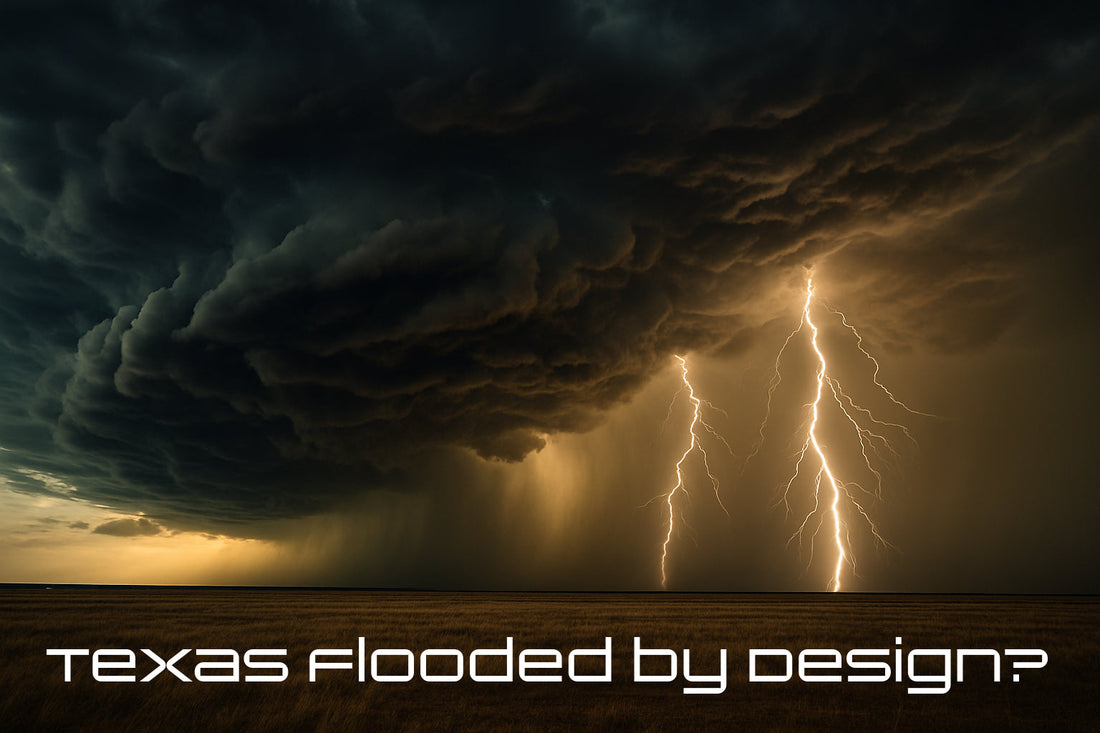Inside the Science—and Suspicion—Behind a “Perfect Storm”
When record rains dumped across central Texas, flooding towns and farmland alike, the official narrative pointed to an act of nature. But a deeper look into the skies—and flight paths—raises another possibility: what if this was helped along?
Look closely at the flight data captured in the days before the flooding. Aircraft following tight, overlapping patterns in known seeding corridors. Aerial activity concentrated in west Texas… with the storm explosion happening directly east, where saturated ground couldn’t take another drop.
Coincidence? Maybe. But if you know what cloud seeding is—and what it’s capable of—you might see this as something more deliberate.
What Is Cloud Seeding?
Cloud seeding is a form of weather modification that involves introducing materials like silver iodide, potassium iodide, or dry ice into clouds to encourage precipitation. Planes, rockets, and now drones release these particles into the upper atmosphere where moisture gathers, stimulating rainfall that might otherwise never fall.
It’s real. It’s regulated. And it’s big business.
Entities involved include:
- NOAA and NASA (U.S. government)
- Rainmaker, Weather Modification Inc., and Seeding Operations & Atmospheric Research (SOAR)
- State-funded programs in places like Texas, California, and Utah
- Foreign governments such as China, Russia, UAE, and Saudi Arabia, all of whom conduct aggressive seeding operations—some via autonomous drones
It’s published, advertised, and even funded with public money. But it can be abused—especially when the atmosphere and ground are already overloaded.
Ground Saturation: When the Earth Can’t Take Any More
Here’s the part the weather reports won’t explain.
Leading up to this Texas flood event, the soil across central Texas was already at or near full saturation. That means any additional rainfall would bypass absorption and immediately become surface runoff. Think of it like pouring a bucket of water onto a sponge that’s already soaked.
The storm wasn’t inherently extreme—but it hit in the worst possible conditions:
- Saturated clay-rich soils
- Low runoff capacity
- Limited aquifer recharge
- Urbanized areas with poor drainage infrastructure
This is the formula that turns moderate rainfall into flash flooding.
Now pair that with seeding operations taking place upwind and you begin to understand why some are calling this engineered—or at least enhanced.
Flight Evidence: The Smoking Sky
The image above captures air traffic patterns in the region during the month leading up to the event. Here’s what we see:
- Tight loops and grids consistent with cloud-seeding operations
- Activity clustered in west Texas and northern Mexico (a typical launch zone for seeding due to prevailing wind patterns)
- The resulting moisture carried by jet stream into central/east Texas where it detonated over already wet ground
The repeating patterns and paths strongly suggest aerial deployment of particulates—likely tied to Weather Modification, LLC, SOAR, NOAA or Rainmaker-type activity.
In other words: the storm wasn’t just bad timing… it was “optimized.”
Final Thoughts: Is This the New Normal?
This isn’t tinfoil hat territory. Cloud seeding is real. Government programs exist. Drone seeding is scaling. And “weather as a force multiplier” has been a military doctrine since at least the Vietnam War (Operation Popeye).
What we’re seeing in Texas may not be a direct attack, but it is a weaponized manipulation of nature—whether for agricultural purposes, drought relief, insurance manipulation, or even testing thresholds.
And when that manipulation meets poor infrastructure and ignored warnings, the damage can be catastrophic.

